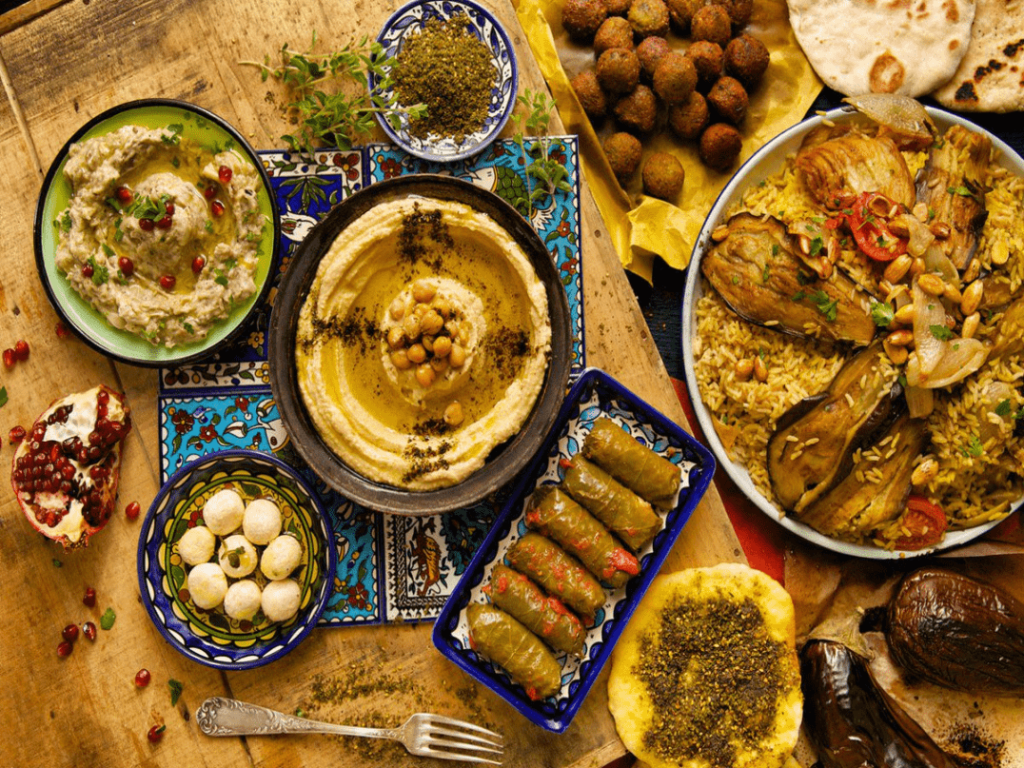For those learning Arabic and eager to connect with the heart of Palestinian culture, prepare your senses for a delightful journey through its vibrant Palestinian food. More than just sustenance, Palestinian dishes are a delicious expression of history, land, and the enduring spirit of its people. From the fragrant aroma of spices to the comforting taste of traditional recipes, Palestine food offers a unique and unforgettable culinary experience. Thus, join us as we uncover the secrets and savor the diverse flavors of traditional Palestinian food and Palestinian cuisine.
A Land Blessed with Flavor: The Foundation of Palestinian Food
Palestinian food is deeply rooted in the region’s fertile land and the resourcefulness of its people. Key ingredients that form the backbone of this flavorful cuisine include:
- Olive Oil (زيت الزيتون – zayt az-zaytūn): Liquid gold, Palestinian olive oil is renowned for its quality and is used generously in countless dishes.
- Za’atar (زعتر): A fragrant blend of thyme, sesame seeds, sumac, and salt, a staple in Palestinian kitchens.
- Bread (خبز – khubz): From fluffy pita to thin markook, bread is an essential accompaniment to every meal.
- Grains (حبوب – ḥubūb): Bulgur, freekeh, and rice are common bases for many dishes.
- Vegetables (خضروات – khuḍrawāt): Tomatoes, cucumbers, onions, eggplant, zucchini, and peppers are abundant and feature prominently.
- Legumes (بقوليات – buqūliyyāt): Chickpeas, lentils, and fava beans are vital sources of protein.
- Meat (لحم – laḥm): Lamb and chicken are frequently used, often slow-cooked or grilled.
- Spices (بهارات – bahārāt): Aromatic spices like cumin, coriander, cinnamon, allspice, and cardamom add depth and warmth.
A Symphony of Palestinian Dishes:
Let’s explore some of the most iconic and beloved examples of traditional Palestinian dishes:
The Hearty Breakfast Table:
- Hummus (حمص): Creamy mashed chickpeas blended with tahini, lemon juice, and garlic. Often drizzled with olive oil and sprinkled with paprika.
- Ful Medames (فول مدمس): Stewed fava beans seasoned with olive oil, lemon juice, garlic. Often topped with fresh herbs and spices.
- Manakeesh (مناقيش): Flatbread topped with za’atar and olive oil (man’oucheh bi za’atar) or cheese (man’oucheh bi jebneh).
The Grand Main Courses:
- Maqluba (مقلوبة): An “upside-down” rice dish layered with fried vegetables (eggplant, cauliflower, and potatoes) and meat (usually chicken or lamb). Flipping onto a serving platter is a show for the skilled cooks!
- Musakhan (مسخن): Roasted chicken baked on a bed of taboon bread generously soaked in olive oil and onions. This dish must not miss the flavor of sumac. Often considered a national dish.
- Mansaf (منسف): While originating in Jordan, variations of this celebratory dish is all over Palestine. Featuring lamb cooked in a fermented dried yogurt sauce (jameed) served over rice and thin bread. Particularly Bedouin communities cook this.
- Qidreh (قدرة): A hearty rice and chickpea stew cooked with chunks of meat (usually lamb.) A blend of aromatic spices will enhance the flavors of this dish in a traditional clay pot.
- Sayyadiyeh (صيادية): A flavorful fish and rice dish, often prepared with white fish cooked in a spiced tomato sauce and served with caramelized onions and nuts.
Comforting Stews and Soups:
- Yakhnet (يخنة): A variety of stews featuring meat or chicken cooked with vegetables like beans, peas, or spinach in a tomato-based broth.
- Shurbat ‘adas (شوربة عدس): A simple yet nourishing lentil soup, often seasoned with cumin and lemon.
Delicious Vegetarian Options:
- Mujadara (مجدرة): A humble yet flavorful dish of lentils and rice (or bulgur) cooked with caramelized onions.
- Fattoush (فتوش): A refreshing Levantine bread salad made with mixed greens, tomatoes, cucumbers, radishes, and toasted or fried pita bread pieces, dressed with a tangy sumac vinaigrette.
- Tabbouleh (تبولة): A vibrant parsley and bulgur salad with tomatoes, cucumbers, onions, mint, lemon juice, and olive oil.
Sweet Endings:
- Kanafeh Nabulsiyeh (كنافة نابلسية): A famous sweet cheese pastry soaked in a sugary syrup (atr) and often topped with crushed pistachios. Originating from Nablus.
- Halawet el Jibn (حلاوة الجبن): A sweet cheese roll filled with clotted cream (ashta) and drizzled with rosewater syrup.
- Ma’amoul (معمول): Small butter cookies filled with dates, walnuts, or pistachios, often made during Eid.
The Heart of the Meal: Sharing and Hospitality:
More than just sustenance, Palestinian food is a central part of social gatherings and family life. Meals are often shared communally, reflecting the warmth and generosity of Palestinian culture. Thus, welcoming guests with abundant and delicious food is a deeply ingrained tradition.
A Taste of Palestine Awaits:
Palestinian cuisine is a vibrant tapestry of flavors, reflecting the land’s bounty and the rich history of its people. From the savory aromas of slow-cooked stews to the sweet indulgence of kanafeh, Palestinian dishes offer a truly authentic and heartwarming culinary experience. We encourage you to.
If you enjoyed this article and would like to learn more about Palestinian culture, or Arab culture in general, or if you’re interested in Levantine Arabic, Kaleela is all you need. As you may already know, researchers have proven that the best way to learn Arabic is through Arabic learning apps. So, start learning the Palestinian-Jordanian dialect now by downloading the Kaleela Arabic learning app to your IOS or Android device today.



